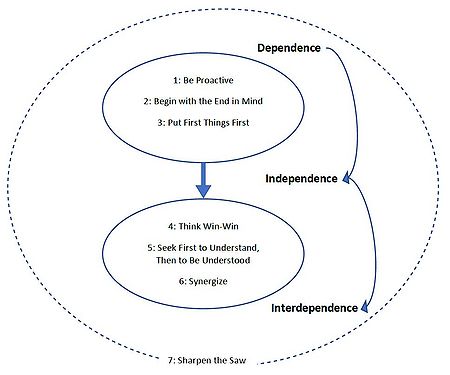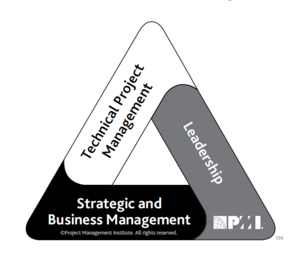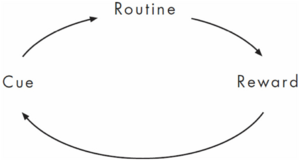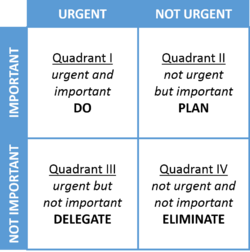The 7 Habits of Highly Effective People for Successful Leadership
Created by Lena Maria Thyen (s202969)
Contents |
Abstract
The skills and competences of a project manager are crucial for a project to succeed. Besides technical project management skills and strategic as well as business management skills, a successful and effective project manager is also characterized by leadership skills and competences. Some of the most important leadership skills, qualities and competences include: being optimistic and positive, being collaborative, being able to managing relationships and conflicts, asking and listening, being a problem solver, being a life-long learner who is results- and action-oriented, being able to focus on the important things, being able to have fun and share humour effectively with team members [1](pp. 51-62). These skills and competences are discussed in the personality development book The 7 Habits of Highly Effective People, which the American author Stephen Covey wrote in 1990. Covey describes an inside-out approach that focuses on character ethics rather than personality ethics. According to Covey, personal and professional success is going to be achieved by adopting these seven habits: 1) be proactive, 2) begin with the end in mind, 3) put first things first, 4) think win-win, 5) seek first to understand, then to be understood, 6) synergize, 7) sharpen the saw. When implementing these habits into the character, three stages 1) dependence, 2) independence and 3) interdependence are passed in succession, which Covey describes as the maturity continuum. The fact that these skills and competences can be trained as habits and thus be integrated into the character enables employees and thus companies to achieve increased effectiveness in project management through the use of this personality development tool [2]. Therefore, this article focusses on the connection between the seven habits of highly effective people and a successful leadership of project managers. Further, instructions on how this tool can be used in the area of project management are given.
The 7 Habits of Highly Effective People
In this personality development book, success is defined out of two different points of view, the personality ethic and the character ethic. Success from the personality ethic perspective is measured in terms of personality, public image, attitudes and behaviors, skills and techniques, that eases the processes of human interaction whereas from the character ethic perspective success is defined in terms of integrity, humility, fidelity, temperance, courage, justice, patience, industry, simplicity and modesty. According to Covey, principles through character ethic are the basis for this inside-out approach and are key to maintain lasting human relationships and to achieve long-term success [2](pp. 7-9). These character ethic-based skills and competencies can be learned by adopting the following seven habits.

1: Be Proactive:
- Take responsibility for your own actions and focus time and energy on the things inside the Circle of Influence which includes things that you can control and influence in order to achieve more positive results. This can for example be your fitness, your education, your hobbies or your habits.
- In order to become a proactive person, it is essential to develop an awareness of what things we can influence with our actions and to focus on them instead of things within the Circle of Concern which we cannot change.
[2](pp. 31-44)
2: Begin with the End in Mind:
- Set yourself a personal mission statement which describes a clear vision of your goals in life.
- Put yourself in the position of an author of your own life. This realization combined with a proactive mindset is supposed to ensure that whenever a decision has to be made, the focus on whether these decisions are in line with one's own goals or with the mission statement of the person you want to be.
[2](pp. 45-73)
3: Put First Things First:
- Prioritize the things that lead you to the goals defined in habit two.
- In habit two you should have understood that you are the author of your own life. This habit is about writing your own life, i.e. turning your visions into reality and making decisions accordingly while thinking proactively.
[2](pp. 73-90)
4: Think Win-Win:
- Acquire a win-win mind-set by being in balance between courage and consideration.
- This has the advantage that while we work together we share our knowledge and can grow and benefit from one another.
[2](pp. 102-119)
5: Seek First to Understand, Then to Be Understood:
- First, listen to understand a person intellectually and emotionally. This type of listening is called empathic listening and is the highest form of listening which creates a feeling of care and empathy.
- Next, give an honest and valuable advice from own point of view if requested.
[2](pp. 119-133)
6: Synergize:
- Cooperate with people with different backgrounds, perspectives, opinions, ideas and strengths in order to incorporate the value of each individual and thereby achieve better results. Through synergy, things can be discovered that someone is less likely to discover alone.
[2](pp. 133-146)
7: Sharpen the Saw:
- Take time for self-care and self-renewal in order to stay balanced and thus to be and stay effective. Here, the saw is used as metaphor. It needs to be sharpened to be able to saw properly.
- Focus on the maintenance of the physical (beneficial eating, exercising and resting), social and emotional (making social and meaningful connections to others) and the mental and spiritual (spending time in nature, spiritual self through meditation, music, art, expand prayer or ministry) conditions. This habit is the basis for staying balanced to be able to handle the other six habits.
[2](pp. 147-158)
In order to become maximally effective and successful it is necessary to reach the highest level of the maturity continuum. The maturity continuum consists of the three successive levels 1) Dependence, 2) Independence, and 3) Interdependence, which describe a person's level of maturity. The development of being dependent to being independent occurs by implementing habits one to three. By adopting these habits an individual will develop inner strength, character purpose and values which helps to become more effective.
By adopting the habits four to six an individual will be able to deal with people, to read the needs of people, to empathize and to corporate with people. These habits enable people to build up strong relationships and to get “we” mindset which helps to think like a team. While implementing habit four to six into the character a person will move from being independent to become interdependent which is Covey describes as the highest possible level of maturity. The seventh and last habit stands for renewal and growth and helps to live a well-balanced life and thus to be able to internalize habits one to six and adopt them optimally [2](pp. 23-25).
Since adopting these seven habits is supposed to lead to success in the professional life, the next section will be about the role of a project manager as an example and how the seven habits of highly effective people can boost the effectiveness being a leader.
Competences and Habits of Highly Effective Project Managers

A project manager is the person chosen by the organization to lead a team that is responsible for achieving a projects objective. The tasks and activities of a project manager can vary depending on the project and organization. In general, however, the skills of a project manager and the way it leads it's team plays a decisive role in achieving the project goal [1](pp. 51-52). The Project Manager Competency Development (PMCD) framework is well suited to structurally assess the skills and competences of potential project managers. The most effective and for that project well-suited project manager should be found by focusing on the three key skill sets 1) Technical project management, 2) Leadership and 3) Strategic and business management, which are shown in The PMI Talent Triangle. In addition, a project manager should balance these three skill sets in order to achieve the highest effectiveness while carrying out a project [1](pp. 56-57).
The three skill sets are described in the PMI's PMBOK ® Guide [1](pp. 57) as follows:
- Technical project management: The knowledge, skills, and behaviours related to specific domains of project, program, and portfolio management. The technical aspects of performing one’s role.
- Leadership: The knowledge, skills, and behaviours needed to guide, motivate, and direct a team, to help an organization achieve its business goals.
- Strategic and business management: The knowledge of and expertise in the industry and organization that enhanced performance and better delivers business outcomes.
In addition to the technical and professional skills relating to project, program, and portfolio management, as well as commercial knowledge and interest, skills in the field of leadership play an equally important role. These competencies correspond to the seven habits of highly effective people, which according to Covey can be learned and developed [1](pp. 56-62) [2](pp. 31-158). Therefore, these will be discussed in more detail in the following.
Leadership Skills and Competences in Project Management
Project management is more than just working with numbers, templates, charts, graphics and computer systems. A common denominator in all projects are people. In addition to leading, motivating and leading the project team, the project manager's leadership skills and qualities are also required when working with project stakeholders, the steering team, and project sponsors. This is why the project manager's leadership qualities such as negotiating skills, resilience, communication, problem solving, critical thinking and interpersonal skills are essential for successful project management [1](pp. 56-62). These skills and competencies or habits, as Covey calls them, can be learned by using the personality development tool 7 habits of highly effective people. The most important leadership skills defined in PMBOK can be assigned to the seven habits of highly effective people as shown in table Leadership skills and competences needed in project management learned by adopting the corresponding habit.
| Habits
1 to 7 |
Leadership Skills and Competences |
|---|---|
| 1: Be Proactive |
|
| 2: Begin with the End in Mind |
|
| 3: Put First Things First |
|
| 4: Think Win-Win |
|
| 5: Seek First to Understand, Then to Be Understood |
|
| 6: Synergize |
|
| 7: Sharpen the Saw |
|
How to Achieve Habits
In order to understand how these or new habits arise or can be trained, the next step is to give a brief insight into what habits actually are. Aristotl once said “We are what we repeatedly do. Excellence, then, is not an act, but a habit” [2](p. 22). Also, according to Covey, the composition of habits forms the character of a person. A habit is the intersection of the knowledge of what to do and why, the skills of how to do, and the desire which is the motivation of want to do. These factors are often unconscious patterns that constantly express our character on a daily basis and determine our effectiveness or ineffectiveness [2](pp. 22-25). So that means that we can influence and change our habits ourselves. In order to make something in our life a habit, we have to work with all the three factors knowledge, skills and desire equally [2](pp. 22-25).
The Habit Loop

There are different ways to learn new habits or to replace them with old habits. This section will focus on how new habits can be implemented into the character. To do this, it is first important to understand the steps involved in this process, the so-called habit loop. The habit loop process is composed of the three components: cue, routine, and reward. o The cue describes the trigger that makes you perform a certain action. A cue can be a specific location, time, emotional state, other people or an immediately preceding action. This can be, for example, getting up in the morning, which acts as an activator for brushing teeth or making coffee. The more often this connection is activated the stronger the cue will get and the more automatically the performance of that action will become. The cue is followed by the routine in the habit loop. o The routine is the actual behavior of a habit. o The reward is the positive reinforcement or a satisfied desire of all kinds, which occurs through the practice of the routine. The reward is the reason that the act becomes and remains a habit. The more satisfying the reward, the easier it is to carry out the routine. In order to finally implement a new habit in the character, a cue must first be identified that activates the routine. Next, a reward must be found that will ensure the routine is performed and kept. A functioning habit loop process is individual and must therefore be individually adapted to each person [3](pp. 312-322).
Covey gives detailed suggestions how the seven habits of highly effective people can be trained and adopted. A brief summary of these suggestions will be given next. For a more detailed description see [2](pp. 31-158).
Adopt The 7 Habits of Highly Effective People

1: Be Proactive: Develop an awareness of what things can be influenced with own actions. For this you can focus on things that for example bother you and try to visualize and analyze whether that is something within the Circle of Concern which you cannot change or within the Circle of Influence which you are able to influence. If it is something within the Circle of Influence try to think about, how you could influence them [2](pp. 31-44).
2: Begin with the End in Mind:
Define your goals and the image of how you want others to see you. Recognize a pattern for the behavior in your life. Apply the principles of mental creation in the next project you will be facing. Write down the results you desire and what steps will lead to those results [2](pp. 45-73).
3: Put First Things First:
Write down your tasks and goals for the next week and allocate these to the quadrants of figure Time Management Matrix and create an action plan accordingly. At the end of that week evaluate how well your plan helped you to translate your deep values and purposes into your daily life [2](pp. 73-90).
4: Think Win-Win:
Next time you will face a situation where you will be attempting to reach an agreement or negotiate a solution try to put yourself in the other person's place and think about which solution would be best for that person. Next, think about a balance between the other persons perspective and your own and find a result which constitute a win for both of you [2](pp. 102-119).
5: Seek First to Understand, Then to Be Understood:
In your next conversation, focus on the person you are talking to and try to look through his eyes in order to really understand what he tries to tell you. Afterwards, repeat what the other person just told you. Additionally, you could observe others in conversation and identify if people are really listening and responding to each other. Focusing on that try to visualize how you would handle a conversation [2](pp. 119-133).
6: Synergize:
Next time you have a disagreement or confrontation with someone you can try to understand the person’s opinion and see the different ways of thinking and perspectives as a chance. Consider ways in which those differences might be beneficial for an alternative solution [2](pp. 133-146).
7: Sharpen the Saw:
Write down activities which charge your soul in all the four dimensions physical, social and emotional mental, spiritual and commit yourself to do them, and to evaluate your performance and results every week [2](pp. 147-158).
For each of Coveys suggestions how to train and adopt the seven habits, it is useful to work with the habit loop and to identify and specify a cue, a routine, and a reward in order to implement these habits smoothly into the character. To benefit from these habits in project management, Coveys personality development tool should be taught and implemented into the daily working life. An example for that is given in the next section.
Implementing The 7 Habits in Project Management
As mentioned before, leadership skills are one of the three key competencies for effective project management. In order to teach potential project managers valuable leadership skills, the personality development tool from Covey is well suited [1](pp. 56-62). There are several ways how this tool can be implemented and thus help a company manage projects more effectively. This could for example occur during a seminar lasting several days where participants and potential project managers will be equipped with tools how to train and adopt the 7 habits of highly effective people. With these tools, the seven habits can be trained independently. This method has already led to success with other companies and employees [5](pp. 493-496).
Limitations
A basic prerequisite for the successful use of this tool is openness and willingness to embrace a change and to learn the seven habits which requires a high self-discipline [2](pp. 31-158). This is why this tool might be a challenge for some people. Another weakness of the seven habits was detected when Carlone’s research discovered that implementing habit 5) Seek First to Understood, Then to Be Understood can led to misunderstandings. He found out that listening to and understanding a person can also act as an approval of their point of view. Another criticism of this tool was that habit four to six were difficult to implement because they required the participation of other people. In addition, it happened that the implementation of habits four to six were viewed as a weakness and thus did not fulfill the actual purpose [5](pp. 493-496).
Conclusion
In summary, it can be said that although Covey's holistic success principle for reaching maximum effectiveness in private and professional life is more than thirty years old, it is still relevant and not outdated. In addition, to the mentioned limitations that this personality development tool can have, the adoption of the seven habits leads in many cases to an increased inner balance and quality of life and thus to personal and professional success [5](pp. 493-496). Also, by using this tool, basic leadership skills and competences are trained, which are required for successful project management. It is therefore recommended that companies consider using this personality development tool for increased effectiveness in project management.
Annotated Bibliography
Project Management Institute (Ed.). (2013). A guide to the project management body of knowledge (PMBOK® guide) - 5th Edition. Newtown Square, Penn.: Project Management Institute.
This book provides the fundamentals of project management with focus on performing projects with effective collaboration and the most valuable knowledge on a wide range of projects. The as best recognized practice for project managers are collected in this book and gives project managers the essential tools to practice project management and deliver organizational results.
Bernacer, J., & Murillo, J. I. (2014). The Aristotelian conception of habit and its contribution to human neuroscience. Frontiers in Human Neuroscience, 8. doi:10.3389/fnhum.2014.00883.
This journal gives an in-depth knowledge and understanding of how habits and human neuroscience are linked. It provides a good understanding what habits are and how they are composed.
R. L., Kliem (2008). Effective communications for project management. New York: Auerbach Publications. doi:https://doi.org/10.1201/9781420062489.
This book provides guidelines for effective communication in project management. Tools for active and effective listening are presented which could be interesting as these can help to implement habit number 5: Seek First to Understand, Then to Be Understood of the 7 habits of highly effective people.
Barrett, D. (2013). Leadership communication 4th Edition. New York: McGraw-Hill Education.
This book is about high effective and productive communication for leaders. It provides theoretical background and guidelines how to gain appropriate communication skills which are relevant for leaders.
Maylor, H. (2010). Project Management. Harlow: Financial Times Prentice Hall.
This book is about fundamentals of project management. It provides a deep insight into effective leadership, team management and explains the importance of different roles in a high performing group with focus on different types of projects and situations.
Wisdom For Life (Director). (2018, January 07). The 7 Habits of Highly Effective People Summary [Video file]. Retrieved February 20, 2021, from https://www.youtube.com/watch?v=WFc08j9eorQ&t=4s.
and
Wisdom For Life (Director). (2018, January 07). The 7 Habits of Highly Effective People Summary (part 2) [Video file]. Retrieved February 20, 2021, from https://www.youtube.com/watch?v=5LbCRx1UbWY&t=1s.
In these videos (part 1 and part 2) the essential principle behind The 7 habits of highly effective people by Covey is given in an easily understandable way to get an overview of this personality development tool.
References
- ↑ 1.0 1.1 1.2 1.3 1.4 1.5 1.6 1.7 1.8 Project Management Institute, Inc.. (2017). Guide to the Project Management Body of Knowledge (PMBOK® Guide) (6th Edition). Project Management Institute, Inc. (PMI). Retrieved from https://app.knovel.com/hotlink/toc/id:kpGPMBKP02/guide-project-management/guide-project-management
- ↑ 2.00 2.01 2.02 2.03 2.04 2.05 2.06 2.07 2.08 2.09 2.10 2.11 2.12 2.13 2.14 2.15 2.16 2.17 2.18 2.19 2.20 2.21 2.22 2.23 2.24 Covey, S. R. (1990). The 7 habits of highly effective people. New York, USA: Fireside.
- ↑ 3.0 3.1 Duhigg, C. (2012). The power of habit: Why we do what we do in life and business. New York: Random House.
- ↑ First things first (book). (2020, November 17). Retrieved February 27, 2021, from https://en.wikipedia.org/wiki/First_Things_First_(book)
- ↑ 5.0 5.1 5.2 Carlone, D. (2001). Management Communication Quarterly. Enablement, Constraint, and the 7 Habits of Highly Effective People, 14(3), 491-497. doi:10.1177/0893318901143007.
Cite error: <ref> tag with name "Aristol" defined in <references> is not used in prior text.